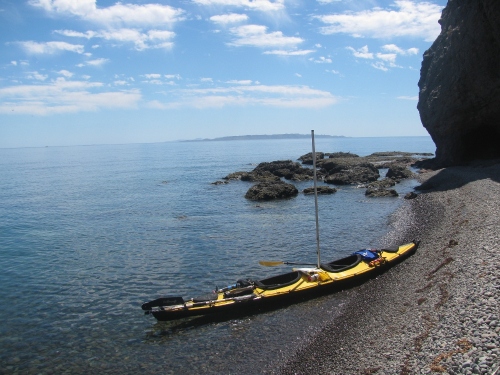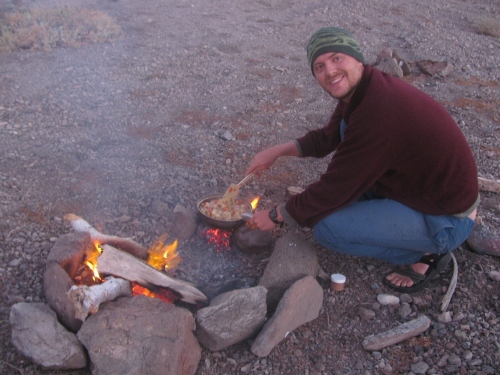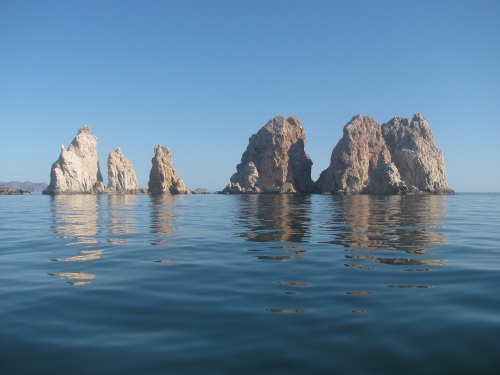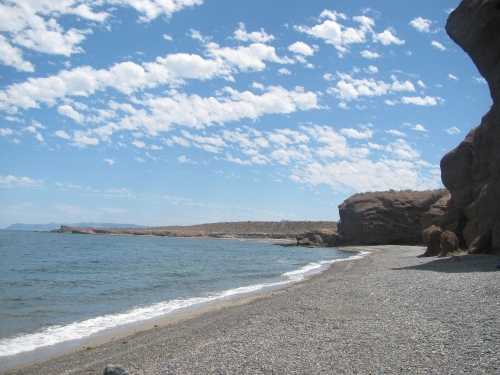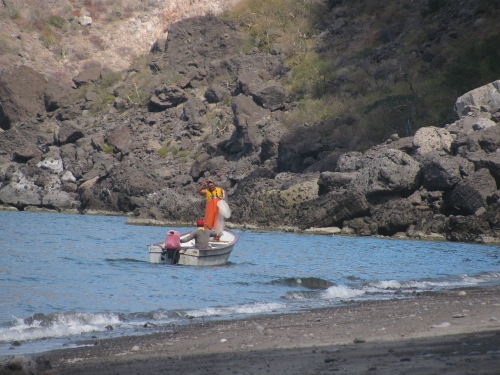The Sea of Cortez is like a great big wilderness tripping Disneyland: it’s beautiful, incredibly fun, almost seems like it was designed for kayaking, and every now and then the ride malfunctions and someone gets killed. It’s almost perfect.
I’ve been planning a big kayak trip here for a long time, and this last March the stars finally aligned and Denae and I found ourselves standing on the shores of Bahia Concepcion (near Mulege), assembling our foldable Feathercraft K2 kayak and preparing to paddle 200 or so miles to the city of La Paz. We’d then take a break in the city before circumnavigating Isla Espiritu Santo, and then drive back to the Loreto area and paddle around Isla Carmen.
To do a trip like this independently requires a lot of logistical planning. We drove down from Oregon, which is a topic in itself that I won’t really get into. You need seaworthy boats and, more importantly, need to have the skills involved with kayaking in potentially dangerous waters. The Sea of Cortez can vary from flat as a pond to large, steep breaking waves and dangerous winds in a disconcertingly short amount of time. The gear list of kayaking equipment, rescue gear, spare parts and repair kits, camping gear, navigational aids, food, etc, seems to stretch on forever. We carried 18 gallons of water (that’s about 150 pounds!) at a time to make it between water sources in this very dry region.
All that said, if you have the skills and equipment, you should go. And if you don’t feel comfortable doing it independently you should start saving your pennies and sign up for a guided trip with one of the many outfitters here. Kayaking Baja was absolutely one of the best trips I’ve ever been on.
We chose to set out from a beach in Bahia Concepcion called Playa Cocos, a place we’d camped out on for a while on a previous trip. We went through our gear at a leisurely pace, spent some time wandering around nearby Mulege and buying last minute provisions, swam and enjoyed ourselves, and before we knew it four nights had gone by living in our little palapa hut. Fun, but the sea was calling our names, so Denae watched our gear while I drove to Loreto and parked our car in an RV park (they charged me $3 usd/day to watch it). We had the second half of our food and fuel in the car for when we reached Loreto. I then took the bus back towards Mulege and had them drop me off at Playa Cocos. The next morning we finally set off.
The first leg of the trip was from Bahia Concepcion to the town of Loreto, about 70 miles to the south. Like most people we chose to paddle north to south to match the prevailing winds. We were both fairly out of shape so we allotted plenty of time and rest days to make it to Loreto, hoping to ease our bodies into the practice of paddling for anywhere from three to ten hours a day.

Our first night's camp. Cobble might not be as scenic as sand, but it's much more comfortale for camping. Sand gets into everything!
We managed to stick to our planned 7am departure time, and paddling out into the bay we could hardly believe we were finally doing it. It was a beautiful morning and we lingered for a while in the middle of the several mile crossing of the bay, floating in the calm water and taking in the scenery. By the time we started rounding the peninsula and heading south a pretty strong headwind had sprung up, and it was looking to be a long haul to our night’s camp. Our spirits and pace were slowly fading when a pod of dolphins swam by, and the excitement powered us through.
The wind kept building that evening and the next morning we woke to large breaking waves and a sea of nasty looking whitecaps… layover day! We spent the day off reading, playing cribbage and hiking around a bit. The next day the wind had mostly died but the seas were still up, and we had an exciting launch powering through the breaking waves. Out in the open water the swells were big enough that we could only see water when we were inside the troughs, but nothing was breaking away from shore so it was easy paddling, if a little nerve-wracking.
We quickly fell into a routine. Get up just as the light was filtering in, pack up camp and eat our breakfast of granola, water and homemade instant breakfast mix (more delicious than it might sound). We’d pile up our load of drybags near the water, carry the kayak to the water and shoehorn everything in. Sunscreen on our face, neck and hands, clothing over everything else, and we’d push off. It always took at least an hour.

Bahia Pulpito, described in our 3 year old guidebook as "out there" in a wilderness sense. We found a big house, airstrip and kids on an atv. Enjoy wilderness while you can folks!
The first couple hours of paddling was usually my favorite part of the day. It would be nice and cool, the winds weren’t usually up yet and the water calm, and the ache in my shoulders wouldn’t yet be distracting from the scenery. And that scenery was spectacular: multicolored cliffs leading straight into the sea, jagged mountains inland, water stretching off to the horizon… We saw lots of wildlife almost every day, from paddling through swarms of diving pelicans and osprey and other sea birds, to sneaking up on sea turtles that would dive and hide as soon as they saw us. Pods of dolphins became almost routine, and we even saw some far off blue whales, identified by their GIANT spouts of water that seemed to hang in the air for minutes, and by the raising of their flukes which apparently distinguishes them from fin whales, the other local plus-sized leviathan.
After our day’s paddle we’d try to find a nice protected landing and campsite, and with the boat still in the water we’d unload our many dry bags and water bladders, then haul the boat up away from the water and tie it up. Shade would then be the priority, hopefully natural in the form of a properly oriented cliff or cave or (very occasionally) tree, and if not we’d set up our shade tarp. We’d set up the tent and secure everything in case of strong winds, and finally have some time to relax or go snorkeling.
Amazingly enough, the hours spent packing, loading and unpacking every day didn’t really get old. It was all part of the process, and the feeling of independence we had from carrying everything we needed inside our kayak was wonderful. Our bodies adapted quickly to their new habits, and we found ourselves becoming leaner and harder and able to paddle much further much easier. It’s a simple life out there, and we loved it.
We reached Loreto 11 days after leaving Bahia Concepcion. Only 7 of those days were actually spent paddling, and that had been at a fairly leisurely pace. We took out at a beach next to the town marina, and I ran and picked up the car where I’d left it at the El Moro RV park, and we shuttled the boat and gear back there using the car. El Moro was a convenient place to park and was right downtown, but camping there was like camping in, well, a parking lot. Not many people seem to tent camp in Baja.

The boat folds down into a couple big duffle bags. Good thing, I don't think the roof racks could handle driving more than the 4 blocks we went after taking this photo.
We camped two nights in Loreto, catching up on our online news and emails, eating lots of tacos and enjoying some cold beers. We replenished our food supplies and water, and were quickly ready to set off again. Loreto is a nice little town, but a little touristy for us and frankly doesn’t compare to the wilderness experience, at least in our opinion. We got up before dark to shuttle everything back to the marina beach, and I re-parked the car at the RV park. Once again we were off!
The following are excerpts from the update email Denae sent out after we reached La Paz:
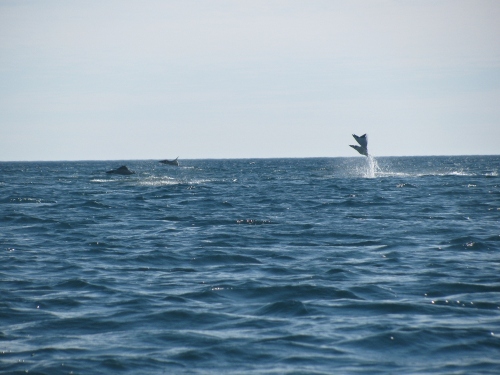
Jumping rays became a several-times-a-day sight once south of Agua Verde. Once a ray landed close enough to splash us.
This video is footage of rays jumping, dolphins, some stormy waters and some snorkeling with sea lions we later did off Espiritu Santo island:
Another especially fun day we spent the morning watching whale spouts off in the distance near Isla San Jose. As we neared camp I saw a whale spout off of a nearby point and didn´t think much of it as we pulled the boat onshore and took out our snacks preparing to relax. All of a sudden the whale appeared 30 feet offshore slowly arching its back showing us that it was a Finn whale. Andy, who was farther away from the water than me, yelled loudly and stared sprinting towards me while I jumped up and down pointing at the water dumbfounded. We tossed our partially eaten Clif Bars into the boat and quickly shoved it back out to sea. We tried following the whale around the bay and, although it never got that close to us again, we fell silent listening to the high pitched sucking noise it made when it took a breath and let out a few moans. Andy did manage to whisper to me, “Do you think you could pass me that Clif Bar?”

I forgot to bleed air out of our sponsons one afternoon, and the heat from the sun burst one of the seams. We didn't notice until after dark, which lead to this repair scene. It takes a while to take apart and assemble the boat, and I was tired and not happy.
We paddled into another bay to be greeted by a pod of especially energetic dolphins leaping clear of the water three at a time and pulling stunts worthy of Sea World, we paddled over a school of yellow tail that were so dense the tornado of fish below us turned the water black, we saw jelly fish, we paddled next to a 6 foot shark slowly passing us by just below the waters surface leaving a sinister feeling in its wake (I am told maybe it was a Nurse Shark?), and we saw too many aquarium fish to count. Packing up our desert camp one morning I was putting on my paddle skirt when I saw a 1.5″ yellow scorpion trying to work his way towards me from the spot where my skirt was laying previously. I´d never seen a scorpion before and although it was smaller than ones I had seen on nature programs I could tell his stinger would still pack a powerful punch.
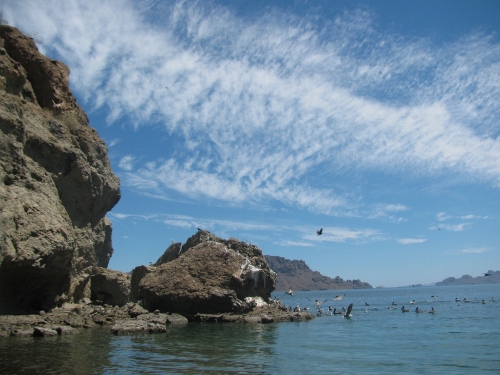
An especially nice camp near Puerto Escondido. The Pelicans were going nuts diving for fish all afternoon, and I caught a beautiful little Roosterfish with my handline.

Sunset at Agua Verde. Somewhere in here we were starting to get the sense that this trip was too good to be true, and yet it just kept getting better.
We are staying in nice hotel which also does guided kayak and boat tours based in La Paz. When Andy went to ask about room availability the owner recognized the tell tale salt deposits covering Andy´s clothing and immediately asked if he needed help with the boat. The pickup was quickly loaded with all of our kayaking gear and driven to the hotel where we were given free reign of the outfitting warehouse to rinse off everything we own in fresh water and to generally do what ever we needed to.
La Paz was not the end of our kayaking trip; we still had Isla Espiritu Santo and Isla Carmen to circumnavigate.

